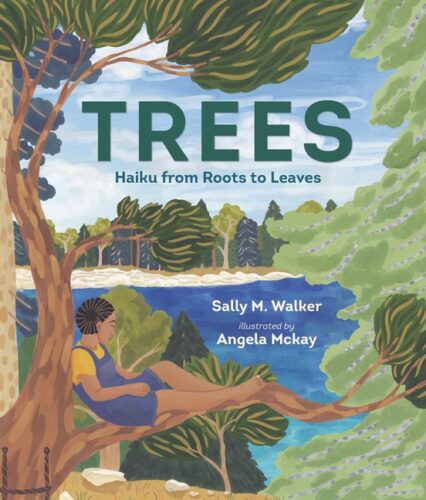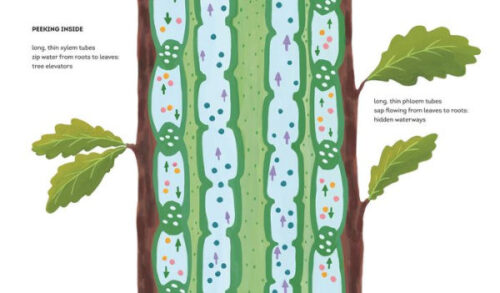Review of the Day – Trees: Haiku from Roots to Leaves by Sally M. Walker, ill. Angela McKay

Trees: Haiku from Roots to Leaves
By Sally M. Walker
Illustrated by Angela Mckay
Candlewick Press
$19.99
ISBN: 978-1-5362-1550-2
On shelves now.
Do you know, do you honestly have any idea, how difficult it is to find brand new high-quality children’s poetry in a given year? There’s a reason we praise folks like Shel Silverstein over and over and over again. Simple children’s poems, charming as they may be, are almost excruciatingly difficult to write. Why this is, I cannot say. What I do know is that I have this little poetry radar in my skull, scanning eternally for new works of poetry for kids. Once located, I read through them all and, almost inevitably, feel disappointed. So let me let you in on a little secret about Trees: Haiku from Roots to Leaves by Sally M. Walker and Angela McKay. The first time I read it? I completely dismissed it. I did! I just sort of read the words “haiku” and “trees”, made my own assumptions, and then (surprise surprise) those assumptions were fulfilled. And that would have been the end of the story, except that somehow Trees ended up in my lunchtime reads pile again. This time, I wasn’t as crabby. I sat down and read the book from cover to cover and found myself completely charmed by it. The lesson of the day then is that walking into books for kids assuming they’ll disappoint you isn’t a great way to go about things. And the happy ending for me is that now I’ve come to thoroughly enjoy this book, and what it manages to do with a minimum number of words per page.
Books of haiku for kids always worry me a little. I suspect this may be because I’ve met different people over the years that would argue that a true haiku poem is more than how many syllables appear in each verse. From what I’ve gathered, a haiku is meant to reconnect you, on some level, to the natural world. But if that’s the bar we’re aiming for then Trees surpasses and surmounts it. This is a book that does not but laud the natural world. The focus is clear-eyed and purposeful. It never strays from its core subject matter (trees) even as it uses that subject as a guide through a wide variety of seasons, settings, and even landscapes.
ADVERTISEMENT
ADVERTISEMENT

And this isn’t Sally M. Walker’s first published book of poetry. Heck, it’s not even her second. I’d forgotten, but she did this marvelous haiku title Out of this World: Star-Studded Haiku not long before this book, and it was a delightful mix of form and deep space. But usually when I think of her name, the first thing that comes to mind are the nonfiction titles she’s written for older readers over the years. I’m not certain what inspired her to aim a bit younger with her titles, but if they continue to be as good as this and Out of this World then I thoroughly approve. The poetry itself was what captured my attention the second time I read this book, by the way. A poem like “covered with gray fur / pussywillow catkins cling: / kittens on sim twigs,” has a way of quietly impressing.
Trees are having a bit of a moment in children’s books right now. Not that they’ve ever been wholly absent, but this year alone I’ve been delighted to discover books like The Tree and the River by Aaron Becker, Nell Plants a Tree by Anne Wynter, Big Tree by Brian Selznick, The Gentle Genius of Trees by Philip Bunting, and many others. Walker, nonfiction advocate that she is, also packs her poems full of tree facts, as you might expect. What’s interesting is that unlike a lot of books about trees coming out right now, she eschews much discussion of the Wood Wide Web, and the fact that trees communicate with one another with the aid of fungi. Mind you, she doesn’t ignore the fact. One poem reads, “airborne scent signals / roots sharing information … / trees communicate.” But she prefers to highlight more traditional tree facts and uses. A lot of this comes out in fairly rote ways, but on occasion she’ll get ambitious and show the intricate inner workings of how water and sap travel inside the trunk. She writes, “long, thin xylem tubes / zip water from roots to leaves: / tree elevators.” Ambitious, to say the least.

Artist Angela Mckay was an interesting choice for the art of this book. Working in gouache and watercolors, I can’t imagine how difficult it must be to create art, good art that is, set to poetry. On the one hand, the sky’s the limit. You could do anything! On the other hand, limitations have their uses. There is such a thing as too much freedom, after all. But Mckay seemingly understands that for a book of poetry to work as a whole, you need to engage in a kind of connected variety. How does one page turn relate to the next? So it is that for poems about winter and snow, she’ll present us with a shot of two people walking, which we look down on from above. Turn the page and we seem to still be high up (perhaps in a tree) only now it’s summer and we’re watching children climb up to a treehouse, our view parallel with the uppermost rung. Linking these images together by p.o.v. is subtle but ultimately it makes for a more even keeled flow as you read.
How do we see this book being used by kids? I’m no teacher, so I can only guess, but this book does feel like an excellent opportunity to kill two birds with one stone. On the one hand, you could just do a normal hey-everybody-let’s-write-haikus unit. On the other hand, I suspect there’s a bigger opportunity here. What if a teacher taught the kids about haikus and read them a couple titles then took them outside and told them to find some aspect of nature that inspired them to make their own haikus? Then you’ve got that sweet spot of STEM and STEAM going on, right? Or maybe I’m complicating things. For parents that just want to give their kids a bit of beauty on the page, reading Trees: Haiku from Roots to Leaves does just that. Quietly engrossing, it’s an appreciation for both subject and form, all wrapped up together. Hug a tree, or write a poem, or just do both.
On shelves now.
Source: Final copy sent from publisher for review.
Filed under: Best Books, Best Books of 2023, Reviews
About Betsy Bird
Betsy Bird is currently the Collection Development Manager of the Evanston Public Library system and a former Materials Specialist for New York Public Library. She has served on Newbery, written for Horn Book, and has done other lovely little things that she'd love to tell you about but that she's sure you'd find more interesting to hear of in person. Her opinions are her own and do not reflect those of EPL, SLJ, or any of the other acronyms you might be able to name. Follow her on Twitter: @fuseeight.
ADVERTISEMENT
ADVERTISEMENT
SLJ Blog Network
Name That LEGO Book Cover! (#53)
Exclusive: Vol. 2 of The Weirn Books Is Coming in October | News
Fighting Public School Book Bans with the Civil Rights Act
North Texas Teen Book Festival 2024 Recap
ADVERTISEMENT







